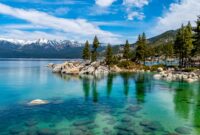Best places for senior trip are a hot topic, and rightfully so! Planning a memorable and enjoyable trip in your golden years requires careful consideration. This guide delves into popular destinations, diverse trip types, budgeting strategies, health and safety concerns, and enriching activities tailored for senior travelers. Whether you envision a relaxing cruise, an adventurous escorted tour, or an independent exploration, we’ll navigate you through the process, ensuring your senior adventure is both fulfilling and worry-free.
From meticulously curated lists of destinations categorized by region and accessibility features, to insightful comparisons of various trip styles, this resource empowers you to make informed decisions. We’ll also address crucial aspects like budgeting, travel insurance, and selecting suitable travel companions. Discover the best places for your senior trip and embark on an unforgettable journey.
Popular Destinations for Senior Travel
Planning a senior trip requires careful consideration of factors like accessibility, comfort, and cultural enrichment. This section details popular destinations catering to the needs and preferences of senior travelers, providing insights into their appeal and practical considerations.
Popular Destinations for Senior Travelers: A Regional Overview
Choosing the right destination is crucial for a memorable and enjoyable senior trip. The following table outlines ten popular destinations, categorized by region, highlighting their key features and average cost ranges. Note that costs are estimates and can vary depending on travel style and time of year.
| Destination | Region | Key Features (Suitable for Seniors) | Average Cost (Range) |
|---|---|---|---|
| Charleston, South Carolina | North America | Rich history, charming architecture, easy-to-navigate streets, excellent culinary scene, relatively flat terrain. | $1500 – $3000 (per person, 7 days) |
| Barcelona, Spain | Europe | Mediterranean climate, beautiful architecture (Gaudi!), vibrant culture, good public transportation, many accessible attractions. | $2500 – $4500 (per person, 7 days) |
| Kyoto, Japan | Asia | Rich cultural heritage, serene gardens, traditional tea houses, efficient public transportation, many accessible temples and shrines. | $3000 – $5000 (per person, 7 days) |
| London, England | Europe | Iconic landmarks, world-class museums, extensive public transportation (including accessible options), many historical sites. | $3000 – $5000 (per person, 7 days) |
| Quebec City, Canada | North America | European charm, cobblestone streets (though some inclines), historical sites, good public transportation, bilingual environment. | $1800 – $3500 (per person, 7 days) |
| San Sebastian, Spain | Europe | Beautiful beaches, stunning Basque Country scenery, excellent food, relatively flat terrain, good public transportation. | $2000 – $4000 (per person, 7 days) |
| Hawaii (Maui or Oahu) | North America | Tropical climate, beautiful beaches, stunning scenery, accessible resorts and hotels, various transportation options. | $3500 – $6000 (per person, 7 days) |
| Florence, Italy | Europe | Renaissance art and architecture, delicious food, relatively compact city center, but some cobblestone streets and hills. | $2800 – $5000 (per person, 7 days) |
| Hoi An, Vietnam | Asia | Charming ancient town, relaxed atmosphere, tailor shops, delicious food, relatively flat terrain, accessible by bicycle or walking. | $1500 – $3000 (per person, 7 days) |
| Buenos Aires, Argentina | South America | Vibrant culture, beautiful architecture, tango shows, good public transportation, many accessible attractions. | $2200 – $4000 (per person, 7 days) |
Accessibility Features in Popular Senior Travel Destinations
Accessibility varies significantly between destinations. Many popular tourist locations are actively improving accessibility for seniors and those with disabilities. For example, Barcelona’s metro system boasts extensive elevator access and many buses are equipped with ramps. Similarly, London’s extensive underground system has improved accessibility in recent years, though navigating some older stations may still present challenges. Many hotels in popular destinations offer accessible rooms with features like roll-in showers and wider doorways. It’s crucial to check specific accessibility features when booking accommodations and transportation. Consider researching specific accessible tour operators specializing in senior travel for a more seamless experience. Pre-planning is essential; contacting hotels and transportation providers directly to inquire about accessibility is recommended.
Types of Senior Trips
Choosing the right senior trip depends heavily on individual preferences, budget, and desired level of activity and independence. This section explores several popular options, outlining their advantages and disadvantages to aid in your decision-making process. Consider factors like mobility, social needs, and travel style when making your selection.
Cruises
Cruises offer a convenient and all-encompassing travel experience. Many cruise lines cater specifically to mature travelers, providing amenities and activities tailored to their needs.
- Advantages: All-inclusive pricing often covers meals, entertainment, and onboard activities. Multiple destinations are visited without the hassle of packing and unpacking. A wide range of social opportunities are available onboard. Many cruises offer accessible accommodations for those with mobility issues.
- Disadvantages: Can be expensive, especially for premium suites and specialty dining. Limited independent exploration at each port. Seasickness can be a concern for some travelers. Large crowds can be overwhelming for some individuals.
Escorted Tours
Escorted tours provide a structured itinerary with a tour guide handling logistics and providing historical and cultural insights. This option is particularly appealing for those who prefer a hassle-free experience with built-in social interaction.
- Advantages: Organized itineraries eliminate the stress of planning. Expert guides enrich the experience with local knowledge. Opportunities for socializing with fellow travelers are abundant. Transportation is typically included, simplifying travel.
- Disadvantages: Less flexibility and independence compared to other options. The pace may be too fast or slow for some. The cost can be significant, especially for longer tours or those including airfare and luxury accommodations. Group dynamics may not always be ideal for everyone.
All-Inclusive Resorts
All-inclusive resorts offer a relaxing and carefree vacation experience. These resorts typically offer a wide array of amenities, including meals, drinks, activities, and entertainment, all included in one price.
- Advantages: Predictable and manageable budgeting. Relaxing atmosphere with minimal planning required. Variety of activities and amenities readily available. Opportunities for socializing with other guests.
- Disadvantages: Limited exploration beyond the resort. Can feel isolated from the local culture. Food options may be repetitive. The overall experience can be less enriching culturally compared to other travel styles.
Independent Travel
Independent travel offers the greatest flexibility and control over the itinerary. This allows seniors to tailor their trip to their specific interests and pace.
- Advantages: Complete control over the itinerary and pace of travel. Opportunity to explore destinations at a personal level. Potential to discover hidden gems and unique experiences. Can be more budget-friendly if carefully planned.
- Disadvantages: Requires significant planning and research. Can be stressful for those less comfortable with independent travel arrangements. May involve more physical exertion, depending on the chosen destinations and activities. Requires a higher level of self-sufficiency and problem-solving skills.
Budgeting and Planning a Senior Trip
Planning a memorable senior trip requires careful consideration of various factors, most importantly, a well-defined budget and a detailed itinerary. Failing to adequately plan financially can lead to unexpected expenses and stress, diminishing the enjoyment of the trip. Thorough planning, however, allows for a relaxed and fulfilling experience.
Creating a Realistic Budget
Developing a realistic budget involves a methodical approach, encompassing all potential expenses. Begin by identifying the trip’s duration and destination. This will significantly influence the overall cost. Next, itemize anticipated expenses. These typically include airfare or ground transportation costs, accommodation fees (considering hotel, cruise, or rental property options), planned activities and excursions, daily spending money for meals and incidentals, and travel insurance. Finally, allocate a contingency fund to cover unforeseen circumstances, such as medical emergencies or flight delays. Remember to factor in potential fluctuations in currency exchange rates if traveling internationally. For example, a two-week trip to Europe might require a budget of $5,000-$10,000 depending on the chosen destinations and travel style, while a domestic trip within the United States might cost significantly less.
Cost-Saving Strategies for Senior Travelers
Several strategies can help seniors minimize travel expenses. Traveling during the off-season or shoulder season (the periods between peak and off-season) often results in lower airfare and accommodation rates. Many airlines and hotels offer senior discounts, providing substantial savings. Consider utilizing budget-friendly accommodation options such as hostels (if comfortable with this style of lodging), guesthouses, or vacation rentals shared with other travelers. Preparing some meals independently instead of constantly dining out can also significantly reduce food costs. Taking advantage of free activities like walking tours, visiting parks, and exploring local markets adds to the experience without straining the budget. For instance, a senior couple could save hundreds of dollars by choosing a smaller hotel outside the main tourist area and cooking some of their own meals.
Step-by-Step Guide to Planning a Senior Trip
Planning a senior trip effectively involves a sequential approach. First, choose a destination that aligns with your interests and physical capabilities. Next, determine the ideal travel dates, considering weather conditions and potential crowds. Once the destination and dates are set, research and book flights and accommodation. Compare prices from multiple airlines and booking platforms to secure the best deals. Similarly, explore different accommodation options and choose one that meets your needs and budget. Then, create a detailed itinerary, including planned activities and excursions. Pre-booking tours and tickets can often secure discounts and avoid long queues. Finally, purchase comprehensive travel insurance to protect against unforeseen events, such as medical emergencies or trip cancellations. This step ensures peace of mind and financial protection throughout the journey.
Health and Safety Considerations for Senior Travelers
Planning a senior trip requires careful consideration of health and safety aspects to ensure a worry-free and enjoyable experience. Failing to adequately address these concerns can significantly impact the trip’s success and potentially lead to unforeseen complications. Prioritizing health and safety allows seniors to fully immerse themselves in the travel experience without undue stress or risk.
Travel insurance and medical preparedness are paramount for senior travelers. The increased risk of health issues associated with age and the potential for unexpected medical emergencies necessitate comprehensive coverage. Furthermore, proactive steps to manage pre-existing conditions and potential health risks during travel are crucial for a smooth journey.
Travel Insurance and Medical Preparedness
Securing comprehensive travel insurance is vital for senior travelers. Policies should cover medical emergencies, including evacuation and repatriation, as well as trip cancellations or interruptions due to unforeseen circumstances. It’s advisable to choose a policy that specifically caters to the needs of older adults, often offering higher coverage limits for medical expenses. Before departure, ensure all necessary medications are readily available, with sufficient quantities to last the entire trip, including a few extra days in case of delays. Carry a detailed medical history, including a list of medications, allergies, and contact information for physicians. Consider consulting your doctor for travel-specific health advice and necessary vaccinations.
Potential Health Risks and Mitigation Strategies
Senior travelers face a higher risk of various health issues during travel, including cardiovascular events, respiratory problems, and falls. These risks can be exacerbated by factors like long flights, changes in climate, and unfamiliar environments. To mitigate these risks, maintaining a healthy lifestyle before and during the trip is crucial. This includes regular exercise, a balanced diet, and adequate hydration. Packing comfortable shoes and clothing that are suitable for the climate is essential to prevent falls and discomfort. For those with pre-existing conditions, it’s vital to pack sufficient medication and follow medical advice diligently. Consider consulting a travel doctor specializing in geriatric travel medicine to address specific health concerns.
Safe and Accessible Accommodations and Transportation
Choosing accommodations and transportation options that cater to the needs of senior travelers is crucial for a safe and comfortable experience. Consider hotels or resorts that offer accessible rooms with features like ramps, grab bars, and roll-in showers. Prioritize accommodations with easy access to medical facilities. For transportation, consider using accessible taxis, private car services, or public transportation systems with readily available assistance. Pre-booking transportation services can help avoid last-minute complications. When selecting tours and excursions, opt for those with a manageable pace and minimal strenuous activities. Familiarize yourself with emergency contact numbers and procedures in your destination.
Activities and Experiences for Senior Travelers
Planning activities for a senior trip requires careful consideration of physical capabilities and interests. The goal is to create a memorable experience that balances engagement and relaxation, promoting both physical and mental well-being. Choosing activities that cater to diverse interests and abilities ensures everyone enjoys the trip to the fullest.
A well-rounded senior trip should offer a variety of experiences, from invigorating cultural explorations to peaceful moments of relaxation. The key is to find a balance that suits the group’s preferences and ensures a comfortable and enjoyable journey for all participants.
Age-Appropriate Activities for Senior Travelers
Senior travelers can enjoy a wide range of activities, tailored to their preferences and physical capabilities. The following examples highlight the diverse options available, emphasizing the benefits each activity offers.
| Interest Category | Activity | Benefits |
|---|---|---|
| History | Guided tour of historical sites (e.g., museums, ancient ruins) | Stimulates cognitive function through learning and exploration; provides opportunities for social interaction and shared experiences; gentle walking can improve cardiovascular health (depending on the site). |
| Nature | Scenic nature walks or leisurely hikes on well-maintained trails | Improves cardiovascular health and muscle strength; reduces stress and improves mood through exposure to nature; provides opportunities for mindful observation and appreciation of the natural world. |
| Culture | Attending local cultural events (e.g., concerts, festivals, cooking classes) | Enriches cultural understanding and appreciation; stimulates cognitive function and creativity; provides opportunities for social interaction and engagement with the local community. |
| Relaxation | Spa treatments (e.g., massages, aromatherapy) | Reduces stress and muscle tension; improves sleep quality; promotes relaxation and well-being; provides a sense of pampering and rejuvenation. |
| Culture | Visiting art galleries or attending theatrical performances | Stimulates creativity and appreciation for art; provides opportunities for intellectual engagement and discussion; offers a chance to enjoy aesthetically pleasing environments. |
| Nature | Gentle boat tours or scenic drives | Provides opportunities to enjoy beautiful landscapes without strenuous physical activity; allows for relaxation and observation; can improve mood and reduce stress. |
| Relaxation | Yoga or tai chi classes | Improves flexibility, balance, and coordination; reduces stress and anxiety; promotes relaxation and mindfulness; suitable for various fitness levels. |
| History | Visiting historical homes or gardens | Provides opportunities to learn about history and architecture; offers a chance to enjoy peaceful and aesthetically pleasing environments; gentle walking can improve cardiovascular health. |
Choosing the Right Travel Companion or Group
Selecting the ideal travel companion or group significantly impacts the enjoyment and success of a senior trip. The decision hinges on individual preferences, travel style, and desired level of independence. Careful consideration of these factors ensures a memorable and stress-free experience.
The choice between solo travel, traveling with a partner, or joining a group presents unique advantages and disadvantages for senior travelers. Solo travel offers maximum independence and flexibility, allowing for spontaneous exploration and personalized itineraries. However, it can also lead to feelings of loneliness or vulnerability, particularly in unfamiliar environments. Traveling with a partner provides companionship, shared experiences, and mutual support, but may require compromise on individual preferences and travel styles. Group travel offers the benefits of camaraderie, shared costs, and organized itineraries, but can sometimes feel restrictive and less personalized.
Personality Compatibility and Travel Companions
Choosing travel companions based on personality compatibility is crucial for a harmonious trip. Shared interests, similar travel styles, and compatible communication styles contribute significantly to a positive travel experience. Differences in energy levels, preferred paces, and tolerance for spontaneity can lead to friction if not addressed beforehand. Open communication about expectations, preferences, and potential challenges is vital before embarking on a shared adventure. For example, a traveler who thrives on structured itineraries might clash with a companion who prefers spontaneous exploration. Pre-trip discussions about daily schedules, activity preferences, and budget expectations can prevent misunderstandings and disagreements during the trip.
Ensuring a Positive Travel Experience with Others
Effective communication is paramount for maintaining positive dynamics within a travel group. Establishing clear communication channels and regularly checking in with companions ensures everyone feels heard and understood. Sharing responsibilities, such as planning activities, managing finances, or handling logistics, fosters a sense of teamwork and mutual support. Compromise and flexibility are essential when navigating differing preferences or unexpected situations. For instance, agreeing to alternate activity choices or adapting plans based on weather conditions demonstrates respect for everyone’s needs and preferences. Regularly scheduled check-ins, even brief ones, can help maintain open communication and address any emerging issues promptly. Building in some independent time for each person can also prevent feelings of being overwhelmed or confined. This allows for individual pursuits and personal space, maintaining a balance between group activities and individual needs.
Illustrative Examples of Senior-Friendly Destinations
Choosing the right destination for a senior trip involves considering factors beyond just scenic beauty. Accessibility, ease of navigation, and the availability of appropriate healthcare are paramount. The following examples showcase destinations that excel in these areas while offering enriching cultural experiences.
Charleston, South Carolina, USA
Charleston offers a delightful blend of history, charm, and accessibility. The city’s relatively flat terrain makes it easy to navigate, whether on foot, by wheelchair, or using one of the readily available electric scooters. Cobblestone streets lend a unique ambiance, though some sections may present slight challenges for those with mobility limitations. However, the abundance of horse-drawn carriages provides a comfortable alternative for sightseeing. The historic architecture, including Rainbow Row’s colorful houses and the grandeur of Fort Sumter, is visually captivating. The gentle sea breezes offer a refreshing respite from the southern heat, especially during the spring and fall months. Charleston’s culinary scene is renowned, offering a wide variety of dining options catering to different tastes and dietary needs. Medical facilities are readily accessible, providing peace of mind for senior travelers. The city’s slower pace of life and friendly atmosphere contribute to a relaxed and enjoyable travel experience. The rich history is easily explored through various walking tours, many of which offer options for different mobility levels. Visitors can immerse themselves in the city’s culture through visits to historic homes, art galleries, and museums, many offering accessible entrances and facilities.
San Sebastian, Spain
Nestled on the picturesque Bay of Biscay, San Sebastian boasts a stunning coastline and a vibrant culture. The city’s relatively compact size and well-maintained pedestrian areas make it easy to explore. While some hills may require a bit more effort, the city’s excellent public transportation system, including accessible buses and trams, ensures convenient movement for everyone. The city’s stunning architecture, including the Art Nouveau buildings along La Concha beach, provides a feast for the eyes. The aroma of fresh seafood from the bustling La Bretxa Market fills the air, while the rhythmic sounds of the waves crashing against the shore create a calming backdrop. San Sebastian’s climate is temperate, with mild winters and warm summers. The city offers a wide array of culinary delights, from pintxos (Basque tapas) to Michelin-starred restaurants. The city’s healthcare system is robust, with several hospitals and clinics easily accessible. The numerous parks and gardens provide peaceful retreats, and the accessible beaches offer opportunities for relaxation and leisurely strolls. Many cultural attractions, including the San Telmo Museum and the Monte Urgull, offer accessible routes and facilities.
Kyoto, Japan
Kyoto, a city steeped in history and tradition, presents a unique and accessible travel experience. While some older temples and shrines may have steps, many offer alternative entrances or ramps for wheelchair users. The city’s meticulously maintained gardens, such as the serene Ryoan-ji Temple’s rock garden, offer a sensory feast of sights, sounds, and scents. The city’s intricate wooden architecture, the vibrant colors of traditional kimonos, and the delicate sounds of traditional Japanese music create a captivating atmosphere. Kyoto’s climate is characterized by distinct seasons, with stunning cherry blossoms in spring and fiery autumn foliage. The city’s public transportation system is efficient and relatively easy to navigate, with many stations featuring elevators and ramps. While some streets are narrow, the city is generally walkable, and rickshaws are available for those who prefer a more relaxed mode of transportation. Kyoto offers a plethora of restaurants catering to various dietary needs, and medical facilities are readily available. The city’s slower pace of life and its emphasis on mindfulness contribute to a tranquil and rejuvenating experience. Many temples and shrines offer accessible viewing areas, allowing visitors to appreciate their beauty and spiritual significance regardless of their mobility.
Wrap-Up
Ultimately, the perfect senior trip hinges on individual preferences and priorities. Whether you prioritize relaxation, cultural immersion, or adventure, thorough planning and careful consideration of your needs are paramount. By utilizing the information and guidance provided in this comprehensive guide, you can confidently embark on a rewarding and memorable journey, creating cherished memories that will last a lifetime. So, start exploring the possibilities and prepare for an exceptional senior travel experience!




